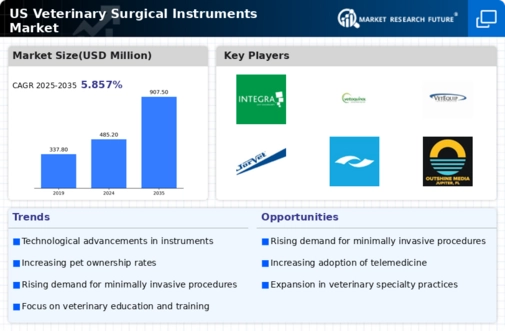The US Veterinary Surgical Instruments Market is characterized by a robust competitive landscape with numerous participants vying for market share. A variety of factors, including technological advancements, high demand for pet healthcare, and an increasing number of veterinary practitioners, greatly influence the dynamics of this market. Key players are focused on innovation, product differentiation, and strategic partnerships to enhance their market position. With increasing cases of pet surgeries due to rising pet ownership and the need for advanced medical procedures, companies in this sector are continually expanding their product offerings and improving their service capabilities.
The competitive environment is also shaped by the regulatory landscape, which mandates high standards for the production and reliability of surgical instruments utilized in veterinary practices.
In the context of the US Veterinary Surgical Instruments Market, Smith and Nephew has established itself as a significant player with a strong portfolio of products. Known for its commitment to quality and innovation, the company has built a reputation for providing advanced surgical instruments tailored for veterinarians. Smith and Nephew leverages its extensive research and development capabilities to introduce cutting-edge technology, ensuring that their instruments meet the evolving needs of veterinary professionals and the patients they care for.
The company’s market presence is bolstered by strong distribution channels and a network of partnerships with veterinary practices, enhancing accessibility to their high-quality instruments. Overall, Smith and Nephew’s focus on quality and innovation positions it favorably in the competitive landscape of the US market.
Ant tailored instruments has carved a niche in the US Veterinary Surgical Instruments Market by offering specialized surgical tools and equipment designed specifically for veterinary applications. The company is recognized for its ability to provide custom solutions that cater to the unique requirements of various veterinary procedures. Ant tailored instruments distinguishes itself through its high-quality product offerings, which have garnered the trust of veterinary practitioners across the country. The company's strengths lie in its innovative design processes and its emphasis on customer feedback, allowing it to stay ahead of market trends.
In addition to its strong product portfolio, Ant tailored instruments actively pursues growth through strategic mergers and acquisitions, enabling it to enhance its capabilities and expand its market reach. By focusing on tailored solutions and leveraging strategic initiatives, Ant tailored instruments continues to strengthen its position in the US Veterinary Surgical Instruments Market.

















